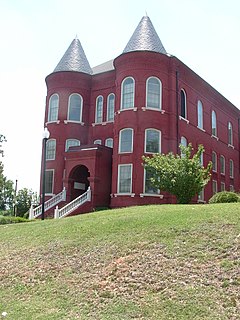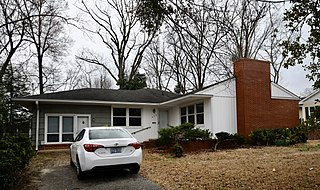
The Capitol Area Historic District is a national historic district located at Raleigh, North Carolina. The district encompasses 25 contributing buildings and was developed after 1792. The district includes notable examples of Classical Revival and Late Gothic Revival style architecture. Located in the district are the following separately listed buildings:

The East Raleigh–South Park Historic District is the largest African-American neighborhood in Raleigh, North Carolina. The district, located south and east of downtown Raleigh, covers approximately 30 blocks and contains portions of the Smith–Haywood and St. Petersburg neighborhoods. Most homes in these neighborhoods were built between 1900 and 1940, with one-fifth dating back to the 19th century. Historic buildings in the district include Estey Hall and Leonard Hall, both located on the campus of Shaw University. The district was listed on the National Register of Historic Places in October 1990.

The West Raleigh Historic District in Raleigh, North Carolina is a national historic district listed on the National Register of Historic Places in 2003. Located 1.5 miles (2.41 km) west-northwest of the State Capitol, the district encompasses approximately 332 acres (134 ha). Neighborhoods in the district include: Bedford Heights, Bagwell, Blue Moon Ridge, College Crest, Fairmont, Forest Hills, Harris-Chamberlain, and Wilmont. Most homes in these neighborhoods are one-story and were constructed between the 1930s to 1950s. While the district is mostly residential, churches and commercial buildings are common along Hillsborough Street.

The Bloomsbury Historic District is a neighborhood and national historic district located near downtown Raleigh, North Carolina. Located north of the Five Points intersection, the boundaries include Fairview Road, St. Mary's Street, Byrd Street, Sunset Drive, and Whitaker Mill Road. The residential district encompasses 439 contributing buildings and was developed between about 1914 and 1950. It includes notable examples of Tudor Revival and Bungalow / American Craftsman style architecture.

The Depot Historic District is an industrial and commercial neighborhood in downtown Raleigh, North Carolina that was the city's railroad and warehouse distribution hub from the 1850s to 1950s. Located two blocks west of Fayetteville Street and to the north and east of the Norfolk and Southern railroad tracks, the district contains four blocks of 35 brick buildings that date from the 1880s to early 1950s. The district encompasses the southwestern portion of Raleigh's original 1792 town plan and was listed on the National Register of Historic Places in 2002.

Glenwood or the Glenwood–Brooklyn Historic District is a historic neighborhood and national historic district located at Raleigh, North Carolina. The district encompasses 286 contributing buildings in an early-20th century streetcar suburb for working- and middle-class whites. Glenwood and Brooklyn were developed between about 1905 to 1951 and includes notable examples of Colonial Revival, Queen Anne, and Bungalow / American Craftsman style architecture. The houses are predominantly 1 1/2- and 2-story frame dwellings.

The Hayes Barton Historic District is a neighborhood located northwest of downtown Raleigh, North Carolina. Hayes Barton, an upper class neighborhood designed by landscape architect Earle Sumner Draper, contains 457 buildings on 1,750 acres (7.1 km2). The neighborhood design includes roads fitted to the contours of the land and features several public parks. The Hayes Barton boundaries are St. Mary's Street, Glenwood Avenue, and Williamson Drive. In 2002, the district was listed on the National Register of Historic Places.

The Maiden Lane Historic District is a national historic district located at Raleigh, North Carolina. The district encompasses 12 contributing residential buildings and was developed between about 1893 and 1923. The district includes notable examples of Queen Anne and Colonial Revival style architecture. Notable houses include the Isabella Morrison Hill House, Irby-Brewer House, Allie H. Kirks House, Love Virginia Davis House, and Frank Brown House (1923).

Boylan Heights is a historic neighborhood in Raleigh, North Carolina. It was added to the National Register of Historic Places as a historic district on July 29, 1985. It is also one of six local Historic Overlay Districts in Raleigh.

Cameron Park is a historic neighborhood just west of downtown Raleigh, North Carolina. It is one of three suburbs platted in the early 20th century. Development began along Hillsborough Street and moved north; a streetcar line along Hillsborough made the location especially appealing and convenient. Cameron Park's developers used restrictive deed covenants that set minimum house prices, created setbacks from the street, and excluded African Americans from living in the neighborhood. Advertisements for Cameron Park openly recruited socially ambitious upper-middle class residents to the neighborhood, and land and house values were significantly higher than those of other early suburbs.

The Roanoke Park Historic District a national historic district located at Raleigh, North Carolina. It is one of the city's historic Five Points neighborhoods and encompasses 446 contributing buildings and 1 contributing site. It is situated southeast of the Five Points intersection of Glenwood Avenue and Fairview and Whitaker Mill Roads. Roanoke Park is composed of six separate plats, filed from 1913 to 1926, and is roughly shaped like a diamond.

Vanguard Park Historic District is a national historic district located between Bloomsbury and Roanoke Park in Raleigh, North Carolina. It is one of Raleigh's historic Five Points neighborhoods. Like Roanoke Park, its homes reflect the variety of popular architectural styles from the 1920s through the 1950s and are similar to those found in the nearby prestigious suburb of Hayes Barton, but are more modest in scale. Notably, the popular Colonial style was not used due to Vanguard Park's narrower lots.

The Battery Heights Historic District is a historic neighborhood and national historic district located southeast of downtown Raleigh, North Carolina, USA. Named for the earthen batteries stationed in the area during the Civil War, the neighborhood has a suburban character, despite its close proximity to the city center.

Capitol Heights Historic District is a historic post-World War II neighborhood and national historic district located just north of the city of Raleigh, North Carolina. The district encompasses 87 contributing buildings and was built between about 1946 and 1949.

The Hi-Mount Historic District is a historic neighborhood located two miles north of downtown Raleigh, North Carolina, United States. The eleven-block district, developed between 1938 and 1951, is one of the city's best-preserved twentieth century speculative neighborhoods. The district encompasses 168 contributing buildings and 1 contributing site. Most of Hi-Mount's homes are Minimal Traditional in style, followed by Cape Cod and Ranch homes with sparse detailing. A small number of developers were involved with the district and the district also benefited from government housing financing programs such as the Federal Housing Administration and the Veteran's Administration, resulting in architectural consistency throughout the neighborhood.

Cameron Village Historic District in Raleigh, North Carolina is a national historic district listed in 2011 on the National Register of Historic Places. The district encompasses 93 contributing buildings and 1 contributing object and was developed between about 1950 and 1955. It is considered North Carolina's first planned mixed-use development.

Longview Gardens Historic District is a historic post-World War II neighborhood and national historic district located 1 1/2-miles east of downtown Raleigh, North Carolina. The district encompasses 189 contributing buildings and five contributing sites. Notable contributing resources include the Raleigh Country Club golf course designed by Donald Ross, Longview Baptist Church and Milner Memorial Presbyterian Church (1946), both striking examples of Modernist architecture.

Rochester Heights Historic District is a historic post-World War II neighborhood and national historic district located 1 1/2-miles southeast of downtown Raleigh, North Carolina. The district encompasses 137 contributing buildings and 1 contributing structure and was developed between about 1957 and 1964. The homes are predominantly constructed in the Ranch and Split-level home styles.

Madonna Acres Historic District is a historic post-World War II neighborhood and national historic district located 1 1/2-miles east of downtown Raleigh, North Carolina. The district encompasses 36 contributing buildings in Raleigh's first subdivision developed by an African American for African Americans. It includes a collection of Split-level and Ranch-style houses constructed of brick with accent walls of stone veneer or wood. A number of the houses feature carports.

Mordecai Place Historic District is a historic neighborhood and national historic district located at Raleigh, North Carolina. The district encompasses 182 contributing buildings and 1 contributing object in the most architecturally varied of Raleigh's early-20th century suburbs for the white middle-class. Mordecai Place was listed on the National Register of Historic Places in February 1998, with a boundary increase in 2000.


















